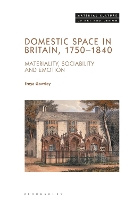


|
|
|
books
| book details |
Domestic Space in Britain, 1750-1840: Materiality, Sociability and Emotion
By (author) Dr. Freya Gowrley

|
This book is currently unavailable. Enquire to check if we can source a used copy
|
| book description |
Between 1750 and 1840, the home took on unprecedented social and emotional significance. Focusing on the design, decoration, and reception of a range of elite and middling class homes from this period, Domestic Space in Britain, 1750-1840 demonstrates that the material culture of domestic life was central to how this function of the home was experienced, expressed, and understood at this time. Examining craft production and collection, gift exchange and written description, inheritance and loss, it carefully unpacks the material processes that made the home a focus for contemporaries’ social and emotional lives. The first book on its subject, Domestic Space in Britain, 1750-1840 employs methodologies from both art history and material culture studies to examine previously unpublished interiors, spaces, texts, images, and objects. Utilising extensive archival research; visual, material, and textual analysis; and histories of emotion, sociability, and materiality, it sheds light on the decoration and reception of a broad array of domestic spaces. In so doing, it writes a new history of late 18th- and early 19th-century domestic space, establishing the materiality of the home as a crucial site for identity formation, social interaction, and emotional expression.
| product details |
Normally shipped |
Publisher | Bloomsbury Publishing PLC
Published date | 10 Mar 2022
Language |
Format | Hardback
Pages | 272
Dimensions | 234 x 156 x 0mm (L x W x H)
Weight | 730g
ISBN | 978-1-5013-4336-0
Readership Age |
BISAC |
| other options |
|
|
|
To view the items in your trolley please sign in.
| sign in |
|
|
|
| specials |
|
|
Let's stare the future down and, instead of fearing AI, become solutionists.
|
|
This first comprehensive biography of Cecil Rhodes in a generation illuminates Rhodes’s vision for the expansion of imperialism in southern Africa, connecting politics and industry to internal development, and examines how this fueled a lasting, white-dominated colonial society.
|
|
|
|